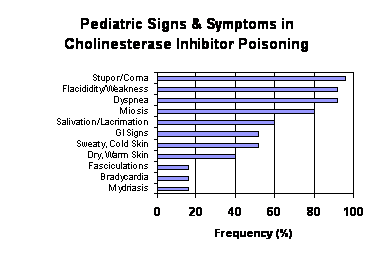Agency for Toxic Substances and Disease Registry
|
Learning Objectives |
Upon completion of this section, you should be able to
|
Differences in Pediatric Cases |
Pediatric cases may present with clinical findings that are different than in adults. Examples include:
Note: Neuromuscular weakness is easy to overlook in a small child --- who may appear very quiet and still --- unless muscle tone is specifically assessed. (Tareg et al. 2001) |
Pediatric Signs and Symptoms | The frequency of pediatric signs and symptoms in cholinesterase poisoning is shown in the Figure 9 below. (Sofer, Tal et al. 1989)
Figure 9. Pediatric signs and symptoms. Data from: Sofer S, Tal A, Shahak E. Carbamate and organophosphate poisoning in early childhood. Pediatric Emergency Care. 1989; 5:222-225. |
Key Points |
|
Progress Check |
Revised 2007-10-16.



